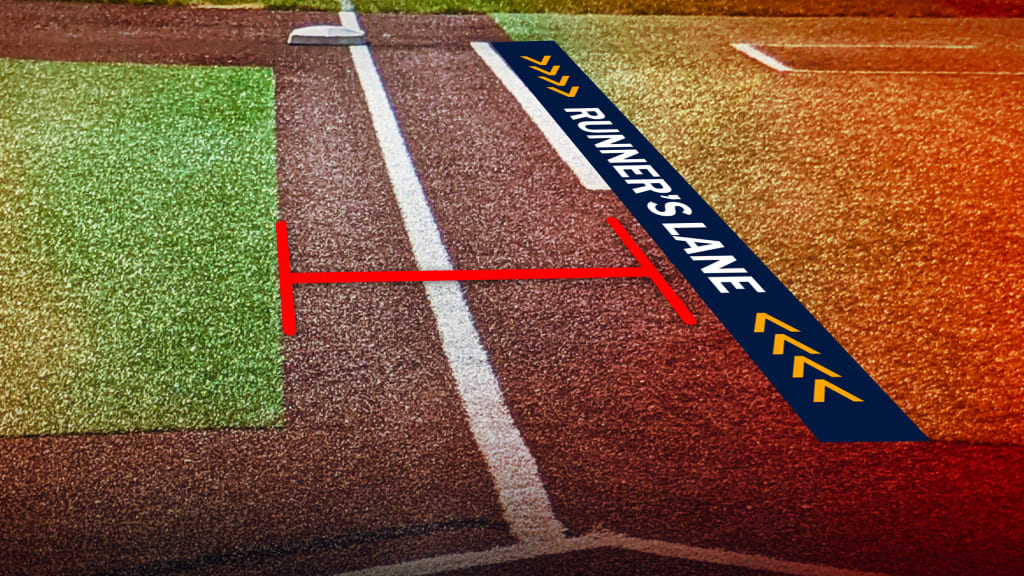With the pitch timer, defensive shift restrictions and bigger bases, the 2023 MLB season featured arguably the most ambitious series of rules changes since the dawn of the game¡¯s Modern Era.
This year¡¯s changes? Much more subtle.
But because these modifications will still impact what we¡¯re watching on a daily basis, it¡¯s important to be cognizant of them. So here¡¯s a rundown of the changes that were approved by the joint Competition Committee over the offseason, as well as new guidance that was provided to umpires for an existing rule regarding obstruction at the bases.
WIDENING OF THE RUNNER¡¯S LANE
Right-handed batters, rejoice. The runner¡¯s lane has been widened to include the dirt between the foul line and the infield grass, providing a more direct path from the right-handed batter¡¯s box to first base. Previously, MLB Rule 5.09 (a)(11) required a batter to run the last half of the distance between home plate and first base between the foul line and a three-foot line drawn on the right-hand side of the dirt.
Under the new rule, this runner¡¯s lane will still be chalked in order to keep runners from drifting too far into foul territory on plays in which the ball is in foul territory (such as dropped third strikes). But instead of forcing the runner to be in foul territory (right of the foul line), the runner will now be deemed in compliance with the rule as long as both feet remain on the dirt path between home and first. The simplicity of ¡°dirt good, grass bad¡± will make for an easier evaluation by umpires.

PITCH TIMER REDUCTION (WITH RUNNERS ON)
The pitch timer has been reduced from 20 seconds to 18 seconds with runners on. It will remain 15 seconds with the bases empty, and pitchers retain the ability to step off (or attempt a pickoff) and reset the clock twice per plate appearance without penalty.
This change was aimed at getting back some of the increase in time of game as 2023 evolved and players became adept at circumventing certain aspects of the pitch timer. While the overall average time for a nine-inning game (2 hours, 39 minutes) was the lowest since 1985, that average went from 2:37 in April to 2:44 in September. Because pitchers began their deliveries with an average of 7.3 seconds remaining on the 20-second timer, they should be able to adjust to the reduction. When a 17-second timer was used for the final month of the Triple-A season in 2023, the violation rate with runners aboard did not increase.
BASE-BLOCKING GUIDANCE
Technically not a new rule but a new guidance on existing rule 6.00(h), which awards the base to the runner when the fielder is ruled to have impeded the runner¡¯s progress while not in possession of the ball and not in the act of fielding the ball. The rule leaves it up to the judgment of the umpire as to whether a fielder is in the act of fielding the ball. MLB¡¯s new guidance asks umpires to call obstruction if they determine a fielder has positioned himself to impede or hinder a runner¡¯s path to the base before receiving the ball. The play remains non-reviewable, and the point of emphasis only applies to the bases, not home plate (which has its own rule regarding when and whether catchers can block the paths of runners).
This guidance was deemed necessary in light of a recent trend in which the league has observed an increase in egregious blocking of the bases, most notably by fielders dropping a knee or leg down in front of the base while receiving a throw to block the runner¡¯s path. This trend runs counter to MLB¡¯s stated goals of increasing aggressiveness on the basepaths via pickoff limits and bigger bases and of reducing injuries. Some players had voiced concerns that the blocking of the bases posed an injury risk to runners, and the new guidance should address that.
PACE-RELATED TWEAKS
In addition to the pitch timer reduction with runners on, there are a few other changes aimed at tightening things up¡
Pitching changes: If a new pitcher steps onto the warning track with less than 2 minutes remaining on the inning break clock, the clock will reset to 2 minutes, rather than 2:15. Inning breaks that contained a pitching change averaged 2:35 in 2023. Broadcasters are only guaranteed two minutes of commercial time.
Mound visits: Each team¡¯s allotment will be reduced from five to four, though an extra mound visit will still be awarded for the ninth inning if the defensive team has zero remaining visits at the end of the eighth. In 2023, clubs averaged only 2.3 mound visits, which surveys show to be among fans¡¯ least favorite events in baseball.
In a further effort to improve pace, umpires will permit defensive players to signal for a mound visit without actually visiting the mound. This addresses situations in which teams use a mound visit not to discuss strategy but, rather, to buy time between pitches.
Circumvention: The pitch clock operator, known as the Field Timing Coordinator, will now restart the clock after a dead ball (such as a foul ball) when the pitcher has the ball and play is ready to resume. There will no longer be a requirement for the pitcher to be on the mound, removing the pitcher¡¯s ability to delay the start of the clock by walking around the edge of the mound.
Batter faced requirement: A pitcher sent to warm up for an inning must face at least one batter (in addition to any requirements under the three-batter minimum rule). MLB found 24 instances in 2023 of a pitcher warming up between innings and getting replaced before throwing a pitch, adding approximately three minutes of dead time per event. There were two such instances during the World Series.

